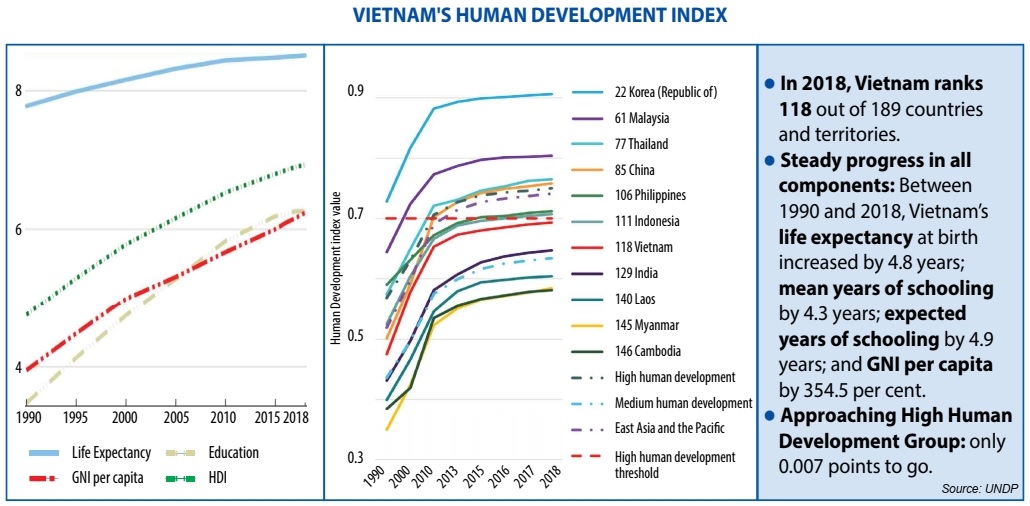Setting the scene for Vietnam’s future human development
 |
| Caitlin Wiesen, resident representative in Vietnam for the United Nations Development Programme |
Vietnam is now at a critical juncture as it designs its next 10-year Socio-Economic Development Strategy and 5-year Socio-Economic Development Plan, in the fast changing and uncertain context as the result of COVID-19 pandemic, the acceleration of Industry 4.0, and climate change.
Between 1990 and 2018 the country’s human development index (HDI) value increased rapidly, with an average annual growth of 1.36 per cent. This places Vietnam among the group of countries with the highest HDI growth rate in the world. Vietnam has shifted from a low HDI country in 1990, to just shy of High Human Development in 2018.
The decisions made today will determine whether the country will continue this human development progress and current pattern of growth with relatively low inequality, or whether new forms of emerging inequalities will be further entrenched and deepened with unsustainable growth pathways.
Failure to address the systemic challenges to tackle a new generation of inequalities will not only slow-down sustainable development in this century, but also further entrench inequalities and harm the progress of human development in the next century.
 |
Achieving equality
One of the hallmarks of Vietnam’s human development progress is that is has been achieved with relatively low increases in inequality. Vietnam’s loss of HDI score due to inequality in 2018 is 16.3 per cent, its loss of income due to inequality is 18.1 per cent, and its Gini(*) coefficient at 35.3 is among the lowest in the East Asia and Pacific region. When considering its inequality adjusted HDI, the country is now eight places higher than its ranking in 2018.
Vietnam has been performing well in terms of gender equality. The gender development index value of 1.003 puts the country in the top group out of five groups of 166 countries in the world, with Vietnam ranking 68th out of 162 countries in gender inequality index.
However, there are key areas for improvement: Vietnam ranks among the bottom third of countries globally in terms of sex ratio at birth (1.12), violence against women by non-intimate partners (34.4 per cent), and women with accounts in financial institutions or with mobile money service providers (30.4 per cent).
In sustainable and environmental development, Vietnam’s forest coverage is among the top third of countries globally. However, it is among the bottom third of countries in terms of carbon emissions per capita. Addressing this will be a key challenge to ensure sustainability of Vietnamese growth.
Importantly, while Vietnam is among the top third of countries in terms of unemployment rates, it is among the bottom third in terms of skilled labour force and vulnerable employment. This reflects a reliance on simple skilled labour and poses a serious risk of losing jobs to automation, potentially deepening inequalities in the next development period.
Inequality cannot be only framed around income, measured by the notion that making money is the most important thing in life. Vietnam has recognised this and was among the several countries in the world that have been pioneering the application of multi-dimensional poverty measurements and approach since 2015.
The country’s achievement in reducing multi-dimensional poverty is also remarkable: with the Multidimensional Poverty Index value of 0.019 Vietnam ranks 29th out of 102 countries and is among the top countries in East Asia and Pacific on this indicator. However, the ethnic minority groups and areas lag behind the national average achievement.
Inequality is also looked at through the lens of distribution of power. Going beyond income will require tackling entrenched social and political norms embedded deep within different nations’ or population groups’ histories and cultures. Dignity in terms of equal treatment and non-discrimination can be even more important than the imbalances in income distribution.
It is important to analyse the life-course gender gaps and inequalities among different population groups and geographical locations.
Vietnam’s disaggregated data show that despite remarkable progress at national level, ethnic minority groups lag behind in many human capabilities such as life expectancy, health and education (especially vocational training and tertiary education), and multi-dimensional poverty. This suggests a challenge for Vietnam to ensure no-one is left behind.
A new generation of inequality
The abilities people will need to compete in the immediate future have evolved. A new gap in advanced human capabilities has opened, such as in tertiary education and digital literacy – opportunities once considered luxuries that are now considered critical to compete and belong, particularly in a knowledge economy, as Industry 4.0 accelerates.
UNDP administrator Achim Steiner pointed out, “We need to avoid a new great divergence in our societies driven by AI and digital technologies. There is historical precedent for technological revolutions to carve deep, persistent inequalities, as took place in the industrial revolution. How we adopt and use new technology is in our hands, and it can be guided to be a force for good.”
At the same time, climate change, gender inequality, conflict, and particularly the coronavirus pandemic with its disproportional negative socioeconomic impacts on the most disadvantaged and vulnerable people, continue to drive and entrench basic and new inequalities alike.
Just as inequality begins at birth and defines opportunities for children, adults, and elders worldwide, and permeates those of the next generation, policies to prevent inequalities can also follow the lifecycle.
Integrated solutions addressing the multidimensional aspects of inequality should be an integral part of the country’s socioeconomic development plans, COVID-19 response and recovery actions.
Such solutions should start early and span throughout three key stages of people’s lives: before they reach the labour market, to address sex birth selection, nutritional, health, and educational gaps between children and young women and men; once they are in the labour market, to harness the power of labour, industrial, gender, and anti-trust policies to level the playing field; and after the market, to make sure taxes, transfers, subsidies, and social services equalise the opportunities for the haves and have-nots.
Politicians and policymakers have a range of choices that, if correctly combined and sequenced will translate into a lifelong investment in equality and sustainability.
Equitably strengthening enhanced human capabilities such as tertiary education and digital literacy, combined with building resilience to shocks due to climate change and health pandemics such as COVID-19, will be vital to Vietnam’s progress in human development in the 21st century.n
(*) Gini coefficient is a measure of the distribution of income across a population developed by the Italian statistician Corrado Gini in 1912.
What the stars mean:
★ Poor ★ ★ Promising ★★★ Good ★★★★ Very good ★★★★★ Exceptional
 Tag:
Tag:
Related Contents
Latest News
More News
- Vietnam’s green transition demands collective financial action (December 15, 2025 | 12:00)
- VIR workshop highlights capital and policy for sustainable development (December 15, 2025 | 11:00)
- National Assembly approves pilot mechanisms to accelerate major projects in Hanoi (December 12, 2025 | 11:29)
- Vietnam eases policy approval requirements, simplifies foreign and outbound investments (December 11, 2025 | 17:53)
- Unpacking new momentum in Vietnam’s M&A market (December 10, 2025 | 09:59)
- Forum honours outstanding M&A deals, strategies, and advisory firms (December 09, 2025 | 18:22)
- Vietnam enters defining phase of M&A growth (December 09, 2025 | 17:00)
- Vietnam’s M&A market opens new opportunities amid strong economic momentum (December 09, 2025 | 15:00)
- Vietnam M&A Forum 2025: new position, new momentum (December 09, 2025 | 14:30)
- FDI in Vietnam jumps on additional capital and share purchases (December 09, 2025 | 13:56)
























 Mobile Version
Mobile Version